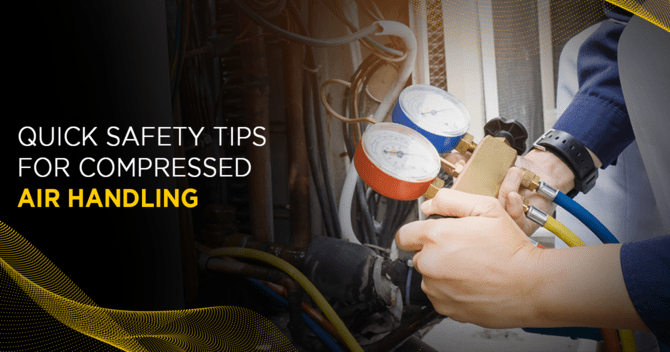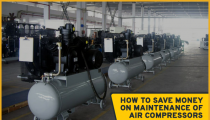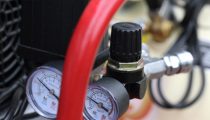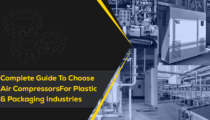Undoubtedly, an air compressor is an integral part of every…

Quick Safety Tips for Compressed Air Handling
Safety should be the priority in any workplace environment, to make sure the employees stay safe and maintain high morale among the entire workforce, reducing the probability of any broken or damaged machinery. Employing safety measures is necessarily important when operating air compressors or other high-powered machinery. Compressed air is such an element which can present numerous risks in the scenario of misuse or a lack of the proper precautions and hence the same amount of care should be taken as with other energy sources. It’s mandatory for all operators to have proper training, along with thorough understanding of safety risks mitigation and potential damage. One can also enquire about all the requisite safety tips and steps that need to be taken from their respective compressed air solution provider.
Read this blog to know the basics of using an air compressor and its operational process like – what to check before use, what parameters to monitor and how to maintain safety for operators and workspaces to minimize air compressor dangers.
1) Workspace and Equipment Setup Safety Tips
The setup of equipment and the entire workspace plays a vital role in the safety aspect. Here’s some workspace and air compressor setup tips to keep in mind:
- Component pressure ratings: Verify properly whether all components like – hoses, fittings and pipes have been rated for the maximum pressure in respect to the air compressor.
- Relief valves: These automatically release air if the pressure becomes too high inside the tank. These valves are crucial safety features of an air compressor tank, and hence one should never try to adjust, remove or bypass them.
- Drain valves: In case of an electric drain valve, it should be kept at least a foot and a half above the ground level as moisture should be avoided for such valves at all times.
- Shutoff valve: The shutoff valve must be placed in a location which is easily visible and within reach during working with compressed air.
- Guards for moving parts: All moving parts like – flywheels, pulleys and belts should be properly guarded.
- Workspace air circulation: The compressor intake air might contain hazardous pollutants and carbon monoxide. Hence, it’s necessary to circulate clean air at the workspace at all times.
- Workspace humidity: It’s vital to maintain the humidity in the workspace at a balanced state. In order to reduce the atmospheric moisture, try – operating an air compressor for longer periods, increasing circulation of air in the workspace, deploying a peripheral crankcase heater or dryer to the compressed air system.
Also Read: How To Remove Moisture From Compressed Air System.
2) Pre-Operation Checks
Before a compressor starts its operational functions, one needs to cross check certain components to ascertain that the machine works properly. One can maintain an air compressor safety checklist to ensure all necessary areas and issues have been checked properly. This check should be undertaken always before a machine starts to work. Some of the elements that needs to be checked are:
- Oil level: One should always check if there is the requisite amount of oil present in the machine. Using it without the required amount of oil can cause it to malfunction to the point where it needs costly repairs or replacement. Adding oil to the reservoir is good but overfilling it should be avoided as oil spilling onto the exterior of a compressor is harmful.
- Lubrication: Recommended lubricants should be adequately applied to all the pneumatic tools to deliver optimum operational efficiency. It’s mandatory to check that lubricants used are not flammable in nature.
- Air filter: Checking the air filter before use is necessary whether a compressor is used daily or only on some days. If it is noticed to be dirty or clogged, it should be removed and washed immediately. Replacing it on periodic intervals is also a good practice to ensure safety and proper working life of an air compressor.
- Air connection: Before starting an air compressor, check whether it is properly connected to the air source. A compressor might not perform as expected or even cause potential injury, if the connection is loose or if the parts get disconnected.
- Outlets: An air compressor should always be used with outlets that come with proper earthing. If an air compressor is plugged into an incorrectly grounded outlet, it has the potential to damage the machine’s internal electrical circuitry and also cause a fatal fire.
- Tools: One has to be extra careful to check that no pneumatic tools attached to the air compressors have pulled triggers when the machine is being powered up or being turned on.
- Fuel level: Sufficient amount of fuel is needed to run a fuel driven compressor. In order to refill it one has to stop and allow the compressor some cooling time before that. Doing it in between jobs can be frustrating. One should only refuel or conduct oil changes when the machine is cold and not right after it has been turned off or is already running.
Zentech System & Solutions provides air compressor and customised services for all kinds of industrial applications and is known as one of the leading “compressed air solution provider(s)”. Contact them for all kinds of best in class air compressors along with numerous curated solutions ranging from – piping, compressor accessories, coolers, dryers and much more




